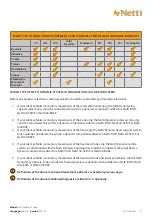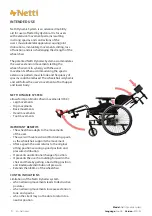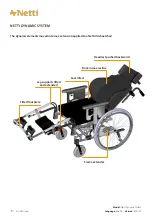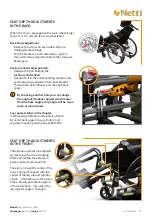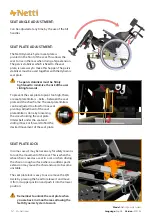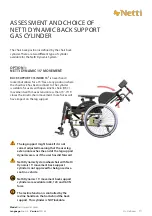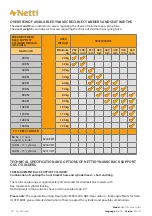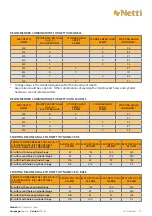
4
My-Netti.com
Model:
Netti Dynamic System
Language:
English
Version:
2021-03
Next page you can see a matrix based on different
diagnosis and suggestions of Netti Dynamic System
parts that could be used. We emphasize that this is
an overview of possible applications and possible
product options / suggestions of Netti Dynamic
System or components. The final solutions should
be based on the findings of an individual seating
assessment, conducted by a trained professional.
ABOUT THIS MANUAL
In order to avoid damages while using the Netti
Dynamic System wheelchair, please study this
manual carefully before starting to use the chair. A
wheelchair with dynamic system must be adjusted
and operated different than static wheelchairs.
Please also pay careful attendtion to the user manual
for the wheelchair where the dynamic system has
been mounted.
The following symbols are used to point out
important points:
Symbol of forbidden actions.
No warranty can be claimed whenever
these actions are implemented.
Symbol of warning.
Whenever this symbol is used,
caution has to be taken.
Symbol for important information.
Symbol for useful tips.
Symbol for tools.
1. INTRODUCTION
The Netti Dynamic System Concept:
What is Netti Dynamic Seating?
Netti Dynamic System is a tilt and recline wheelchair
which allows controlled Open Kinetic Chain (OK-C)
movements of the user. Static comfort wheelchairs
can be accommodated to support the user’s distal
segments. The controlled OK-C movement has an
extra impact: The distal segments can move, with
a moderate resistance. OK-C helps to gain control
of the proximal segments, especially when the user
cannot inhibit muscle movements due to their
medical condition.
Netti Dynamic System is a modular system that can
be customized and adjusted according to the user’s
need.
Typically Netti Dynamic System or its components
may be used for wheelchair users with involuntary
movements.
EXAMPLES OF INVOLUNTARY MOVEMENTS ARE:
•
Dystonia
– involuntary, sustained or intermittent
muscle contractions that can cause twisting and
repetitive movements, abnormal posture or both.
Muscle tone varies from normal or hypotonia to
hypertonia.
•
Athetosis
– slow, involuntary writhing movement.
•
Chorea
– brief, irregular jerking movements.
•
Tremor
– this is a rhythmic movement of part of
the body.
•
Hemiballism
– these are wild flinging / throwing
movements of one arm or leg, usually occurring as
a result of a cerebrovascular event.
•
Clonus
– rapid muscle jerks that are frequently
repetitive.
Before using Netti Dynamic System (NDS)
or any of its components, a seating
assessment should be carried out
by a trained professional.





